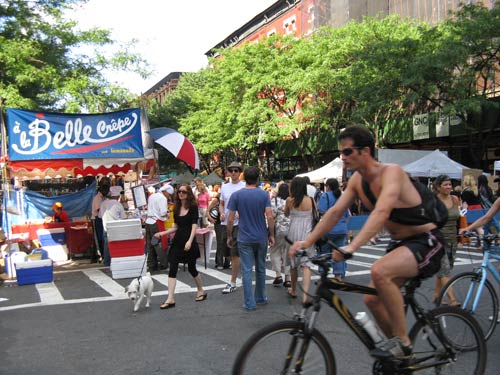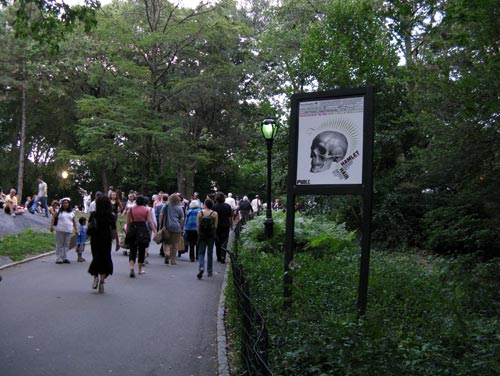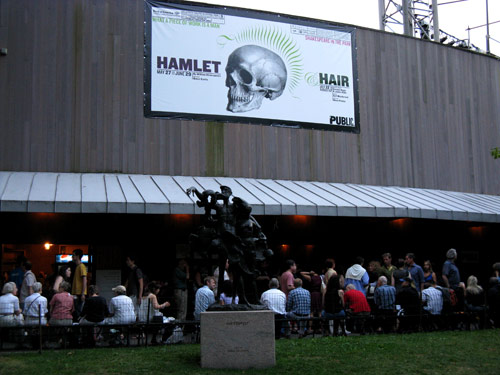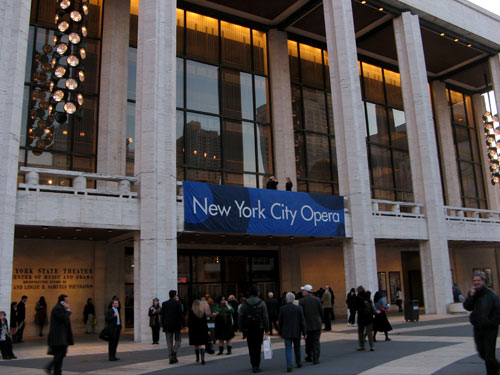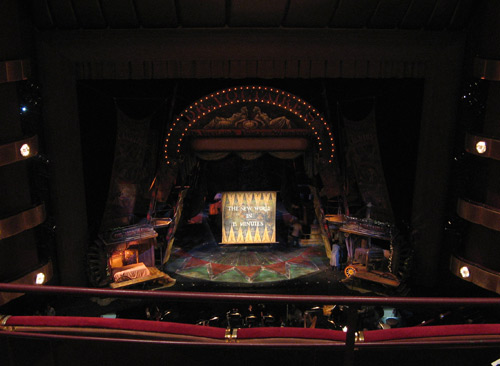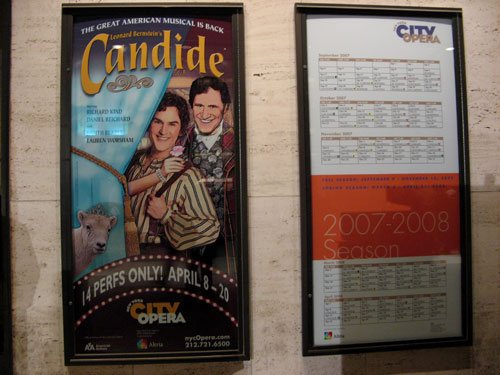Tag: musicals
I believe in love
Another summer Sunday, another street fair. This one was just a preview of the larger Columbus Avenue Festival which will be taking place on September 21, 2008 between 66th and 86th Streets.
After a late May visit to Central Park’s Delacorte Theater for Hamlet, we continued the summer streak with Shakespeare in the Park’s second production: Hair. This time, it was SYB who scored a pair of tickets through the Public’s virtual line. (No Craigslist for us.)
The landmark rock musical was presented here (also for free) last September in a concert staging to commemorate the 40th anniversary of its debut at the Public Theater’s inaugural 1967 season. The music by Galt MacDermot, with lyrics by Gerome Ragni and James Rado, is notable as an era-defining soundtrack, but remain familiar to the Flower Children’s children through television commercials… and the closing credits of The 40 Year Old Virgin.
The Public’s impassioned artistic director Oskar Eustis, profiled in The Times in June, introduced tonight’s performance by underscoring the continuing relevance of Hair’s anti-Vietnam War anthems by drawing parallels with our current “unpopular war abroad” — a sentiment greeted by enthusiastic applause.
(As for the connection to Shakespeare, one need look no further than the song “What a Piece of Work is Man,” which draws almost entirely from Hamlet’s famous speech.)
Joyous performances by a diverse and wildly charismatic cast (under the direction of Diane Paulus), the 12-piece on-stage band, that famous flash of group nudity… Although Hair is in structure little more than a revue with just the wispiest suggestion of a storyline, this is one situation where the whole truly is more than the sum of its quaintly dated parts. And how about “the duo of hotness” that is Jonathan Groff and Will Swenson? (Groff is best known for his Tony-nominated role as Melchior Gabor in Broadway’s Spring Awakening; Christopher J. Hanke took over the role of Claude on August 17 and will remain through the show’s extended September 14 run, replacing Groff, who had a prior commitment.)
Check out the lauding reviews from New York magazine, The Post, Variety, Time Out New York, and The Times.
From the opening “Aquarius” to the plaintive “Let The Sun Shine In” finale, it seemed at times that half of those in attendance were singing along with the performers. When the show reached its explosive conclusion, and the entire audience was invited on stage for a riotous dance with the actors and musicians, we could not help but be swept up in the Summer of Love… or at least the 2008 approximation of it.
Flickr preview: Labor Day at the U.S. Open, 4th Round, featuring Andy Murray and Serena Williams, both of whom advanced to the semis. Also: cast members from HBO’s Entourage.
Candide indeed
At the New York State Theater tonight for a performance Leonard Bernstein’s Candide. This production returned to the New York City Opera repertoire for fourteen performances in April after a three-year hiatus.
Candide’s journey from page to stage was famously bumpy. Bernstein himself never seemed completely satisfied with the work, which he envisioned as an American version of a Gilbert & Sullivan operetta. (It’s billed at the NYC Opera as “The Great American Opera.”) He and playwright Lillian Hellman began collaborating on the musical adaptation of Voltaire’s satirical novel in 1954, united in their indignation over the anti-Communist McCarthy hearings. The heavily revised work, which also featured contributions from poet Richard Wilbur and Hellman’s friend Dorothy Parker — opened on Broadway in 1956, and closed after an abysmal 73 performances.
When Hellman refused to work on a rewrite, additional collaborators were brought in; over the next twenty years, six writers contributed lyrics, characters were modified and redrafted, and segments of the operetta edited in and out. Distinguished director-producer Harold “Hal” Prince (West Side Story, Cabaret) revived the operetta in one form for Broadway in 1974, where it enjoyed a 740 performance run, and won that year’s Tony for Hugh Wheeler’s new book.
Yet another Prince production — known as “the opera house version” – debuted at the State Theater in 1982 with lyrics by Wilbur, and additional lyrics by Bernstein, John Latouche and Stephen Sondheim. It restored numerous sections of music that had been previously discarded, in response to requests from opera companies for a more legitimate version of Bernstein’s vision.
Audiences are often conflicted over their response to Candide, unsure of whether to approach it as a musical or as an opera. Although the score is almost universally admired — the original 1956 Broadway cast recording has something of a cult following — as a dramatic work, it loses momentum in the filler-heavy second half before settling into its final, improbably happy ending – banishments, betrayals, beatings, murders, rapes, shipwreck, plague and earthquake all forgotten. (Did I mention that it’s a comedy?)
Stage and screen star Richard Kind led the cast in the dual roles of Dr. Pangloss/Voltaire. Daniel Reichard, who created the role of Bob Gaudio in Jersey Boys on Broadway, was set to star as the ever-optimistic protagonist, but shortly before curtain it was announced that he was battling a stomach flu and would be unable to perform that night. His understudy Shonn Wiley stepped into the lead, performing with confident ease, offering not a hint that this was his debut of the role. For his efforts, Wiley received cheers and a standing ovation – the most enthusiastic reception of the night.
And let us try,
Before we die,
To make some sense of life.
We’re neither pure, nor wise, nor good
We’ll do the best we know.
— Candide, “Make Our Garden Grow”
Wouldn’t it be loverly?
When I read that My Fair Lady was going to be playing at the MoMA as part of “Rex Harrison: A Centenary Tribute” (March 5–24, 2008), I knew I would find the time to go. The 1964 film is one of my all-time favorites – one of three musicals to which I can sing along to just about every song. (The others are The Sound of Music and West Side Story.)
Roger Ebert called My Fair Lady “the best and most unlikely of musicals…The songs are literate and beloved; some romantic, some comic, some nonsense, some surprisingly philosophical, every single one wonderful.”
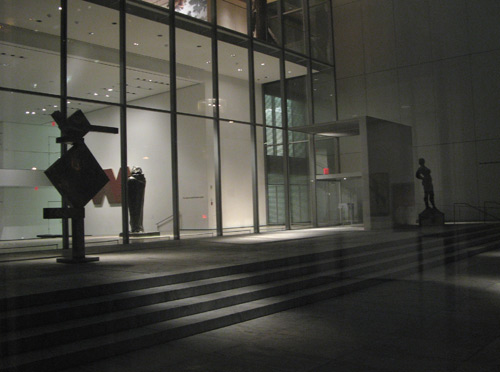
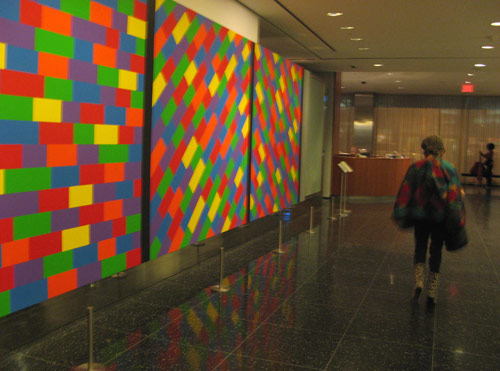
Controversy surrounded the casting of Audrey Hepburn instead of Julie Andrews for the part of Eliza Doolittle; Andrews had originated the role on stage to great acclaim, but producer and Warner Bros. Studio head Jack L. Warner chose established movie actress Hepburn for her greater box-office appeal. My Fair Lady went on to be nominated for twelve Oscars, winning eight (including best picture, actor and director). Hepburn, whose songs were (in)famously dubbed by Marni Nixon, was not nominated for Best Actress that year; ironically, Andrews was nominated… and won for Mary Poppins. In his Academy Award acceptance speech, Rex Harrison, the man who had played Professor Henry Higgins opposite them both, thanked “two fair ladies.”
The MoMA theater was packed tonight with fellow devotees of Hepburn and Harrison’s repartee, Lerner & Loewe’s classic songs and photographer Cecil Beaton’s delightful costumes.
The My Fair Lady DVD has a dual soundtrack, which features two songs with Hepburn’s original singing voice so listeners can judge for themselves how inadequate it was. (Contrast the scene with Nixon’s final cut here.) Interestingly, Harrison himself, despite extensive vocal training, was unable to sing his role either, which resulted in his signature quasi-speaking song delivery throughout the film. Sexy Rexy‘s deliciously patrician tones reportedly inspired the voice of Stewie Griffin on “Family Guy”.
| S | M | T | W | T | F | S |
|---|---|---|---|---|---|---|
| 1 | 2 | 3 | 4 | 5 | ||
| 6 | 7 | 8 | 9 | 10 | 11 | 12 |
| 13 | 14 | 15 | 16 | 17 | 18 | 19 |
| 20 | 21 | 22 | 23 | 24 | 25 | 26 |
| 27 | 28 | 29 | 30 | |||
Search
Popular Tags
Categories
Archive
- July 2010
- July 2009
- January 2009
- November 2008
- September 2008
- August 2008
- July 2008
- June 2008
- May 2008
- April 2008
- March 2008
- February 2008
- January 2008
- December 2007
- November 2007
- October 2007
- September 2007
- August 2007
- July 2007
- June 2007
- May 2007
- April 2007
- March 2007
- February 2007
- January 2007
- December 2006
- November 2006
- October 2006
- September 2006
- August 2006
- July 2006
- June 2006
